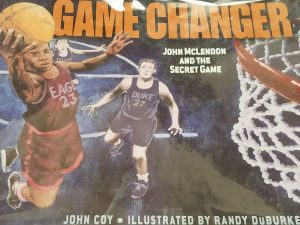
Title: Game Changer
Author: John Coy
Illustrator: Randy DuBurke
Publisher and Year: Carolrhoda Books (October 1, 2015)
Number of pages: 32
Tags/Themes: Diversity, Picture Book, Social Science, 4-5, 6-8, Evan White
Genre: History; Non-fiction; sports
Descriptive Annotation: Game changer is the true story of Coach John McLendon organizing a basketball game between the best white college basketball players from Duke University Medical School and his team from North Carolina College of Negroes in 1944, whose team was called the Eagles. The teams met up in a gym and locked the doors so no one could walk in. Both teams played as hard as they could but the Eagles won 88 to 44. The next day, the two teams decided to play again, but mix the teams up. This was the first time there was inter racial basketball. The boys all had a great time playing mixed together but also knew it was not socially unacceptable if outsiders found out. All the boys began to grow closer together and learn from one another. The artwork of the book is very dark but the tone of the writing has a message of optimism of time changing. At the back of the book, there is a timeline of civil rights movement and progression of black athletes coming into the spot light.
The students will need to know about segregation, the term negroes, prejudice, and the KKK.
Classroom Application: This text can be used to reinforce history, and could be used as the sports perspective within civil rights. The book also explores the progression of equality in America in different areas, like sports. Game Changer can also be used to reinforce history with breaking down barriers. As the coach did a brave thing for the time period and can teach how it is important to take risks that go against social norms. A social norm doesn’t mean it’s a moral norm, so taking risks and stepping outside of comfortable spaces can lead to impact on society.
Linguistic and Cultural Diversity Analysis: This book represents the culture in the 1940s and how the black community stood together to progress in equality. This book could be used to generate discussion in looking at current sports diversity and examine if they are diverse, how diverse, and if certain groups are not represented in sports. This can be done by using percentages and ratios of diverse athletes with a math reinforcement. Using the charts, we can look at the time the athletes were playing. “Nineteen years before Dr. King’s “I have a Dream” speech and three years before Jackie Robinson broke the color line in Major League Baseball, black players and white players worked together as teammates in an illegal game in segregated North Caroline” (19). I think this quote is important because it established there are leaders in civil rights other than Martin Luther King. It is important to learn about more than one leader, and how there was multiple leaders in civil rights through the years, no matter how famous they became. Learning about strong leaders would lead into this next quote. “A reporter for the Caroline Times, Durham’s black weekly newspaper, heard about the game, but he agreed not to publish the story at McLendon’s request since the Ku Klux Klan was active and considered ‘race mixing’ a crime punishable by death” (24). This is a powerful quote that should be used with a mature class ready for these topics. This quote shows the serious tone of the book and paints a picture of how brave the boys were for playing in an interracial basketball game. Understanding the serious consequences makes the coach and players stronger leaders for the students.
